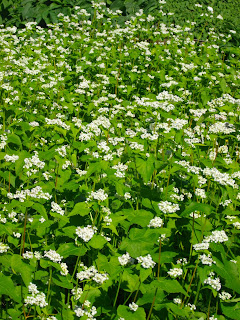In the picture below you will find a lady bug and several aphids. Aphids are soft-bodied insects that feed on the sap of plants; they are considered pests because they damage the ability of the plant to provide nutrients to its leaves. Aphids also accumulate rather quickly, so if one is found, many more will follow. Luckily, aphids can usually be removed by spraying them off with water or hand picking. Larger infestation issues can be resolved with homemade garlic or pepper sprays.
Photo of ladybuy and aphids courtest of Dave Gunn
 IPM is a targeted approach to reducing pest populations and is based on the following principles and techniques:
IPM is a targeted approach to reducing pest populations and is based on the following principles and techniques:1. There is an acceptable level of pest population. Prior to commercial agriculture many farmers accepted that they would lose a small percentage of their yield to pests. Over time, the standardization of more potent pesticides and elaborate applications (such as crop dusting) changed the expectation of commercial farmers. IPM developed as an alternative to widespread pesticide use in the 1950s throughout the US, when indiscriminate field spraying began to occur on commercial agriculture sites.
 3. Monitoring. Monitoring is the key to success with IPM practices. Careful observation and identification of which species are harming the garden will allow the gardener to determine the best method of pest control.
3. Monitoring. Monitoring is the key to success with IPM practices. Careful observation and identification of which species are harming the garden will allow the gardener to determine the best method of pest control.
4. Appropriate control mechanisms. There are essentially three control mechanisms used in IPM: mechanical, biological, and limited pesticidal controls. When pest populations are low and localilized, mechanical controls (such as hand-picking or water spraying) can remove pests best. Biological controls include the use of natural sprays, intercropping, and incorporating plant species that attract natural enemies of pests. Finally, limited pesticidal controls are used when both mechanical and biological controls have failed. A targeted application of a pesticide may be used to reduce the pest population.
You can practice Integrated Pest Management in your school's garden. In late January/early February, start planning your garden. This is easily done by tracing an outline of your planting area and creating symbols for different plants. Incorporate the concepts of intercropping into your garden design. Also, try to include nectar-producing plants which tend to attract a variety of pest enemies naturally. Other plants to try: marigolds, peppers, and garlic.
For a list of plants to combat particular pest species see: http://en.wikipedia.org/wiki/List_of_repellent_plants
For more information on IPM: http://www.ipm.ucdavis.edu/GENERAL/whatisipm.html

 -Once the seeds are planted, be sure to water each section at the same time and with the same amount of water. You can also use the planting guide on the back of the seed packet to identify ideal watering and planting conditions.
-Once the seeds are planted, be sure to water each section at the same time and with the same amount of water. You can also use the planting guide on the back of the seed packet to identify ideal watering and planting conditions.







































